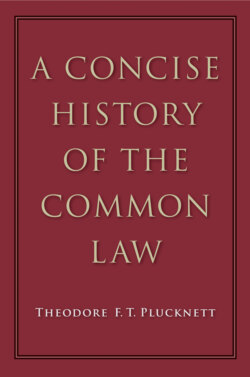Читать книгу A Concise History of the Common Law - Theodore F. T. Plucknett - Страница 71
На сайте Литреса книга снята с продажи.
MERCHANTS AND FINANCE
ОглавлениеAlthough the middle ages were so predominantly agricultural, it is still possible and indeed very necessary to trace in them the beginnings of commerce. In English history two commodities are of particular significance, wool and wine. Wool-growing was the great source of England’s position in international politics during the middle ages. The wool which was grown in England was exported to Flanders, and there in the great Flemish fairs it was distributed throughout Europe. England’s monopoly of wool was so effective that the Crown could afford to leavy heavy taxes upon its export, and upon occasion could bring powerful pressure to bear on foreign nations by diverting the wool trade from one port to another, or even by suspending it altogether. Financially, the wool trade was conducted on a capitalistic basis. In its early days, the leaders of the industry were the Cistercian monks whose mode of life was to build their abbeys in remote places among the hills and occupy themselves with sheep farming. As for the smaller growers of wool, it seems that arrangements were made to buy up their crops in advance, the sale being effected through the assistance of foreign capital. It is significant that credit took the form principally of advanced payments to the growers for future delivery.4 Middlemen were a prominent feature of the trade and behind them stood great foreign capitalists. The same was true of the important import trade in wine. It is obvious that we have here complicated relationships involving very important interests, and we may be certain that the result must have been the development of a good deal of commercial law. It is typical of the middle ages, however, that this law should be not the law of the land but the law of a particular class of people, developed through their custom and enforced through their own organisation. As for the capitalists whom we have mentioned, their place becomes increasingly important through the middle ages. In England a large part was played by the Jews until they were expelled by Edward I. Their place was then taken by various groups of bankers from the cities of northern Italy—the financial centre of London is still called Lombard Street. A considerable place too was occupied by certain religious orders whose international organisation was a convenient machinery ready-made for large-scale banking.1 Their considerable wealth also enabled them at one time to undertake capitalistic operations (although by the close of the middle ages many monasteries were in financial difficulties as a result of heavy royal and papal taxation). Indeed, this tendency of large religious organisations being deeply involved in finance persisted into modern times; in more than one country the principal cause for the expulsion of the Jesuits in the eighteenth and nineteenth centuries was a fear of their financial activities.
As for manufacturers, development was at first most rapid in Flanders where English wool was made up on a large scale. It was to Edward III that credit is largely due for the establishment of the textile industry in England. His Queen was Flemish, and it may be her connection with Flanders which led him to invite some Flemish weavers to settle in England.2 Nevertheless, the English textile industry was still purely domestic, that is to say, carried on in the home of the worker, and not in a factory.
